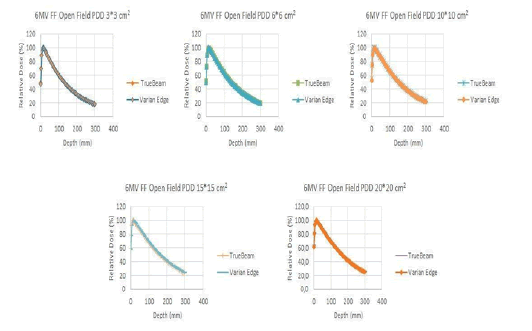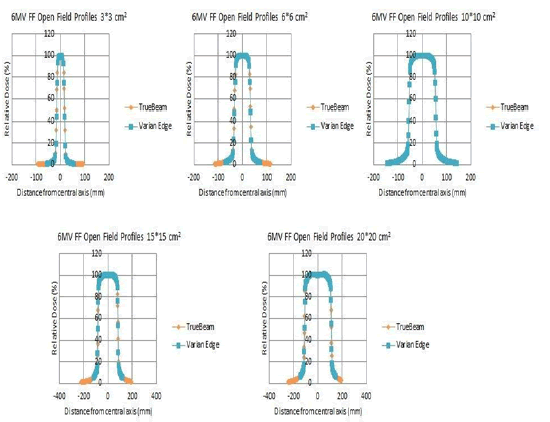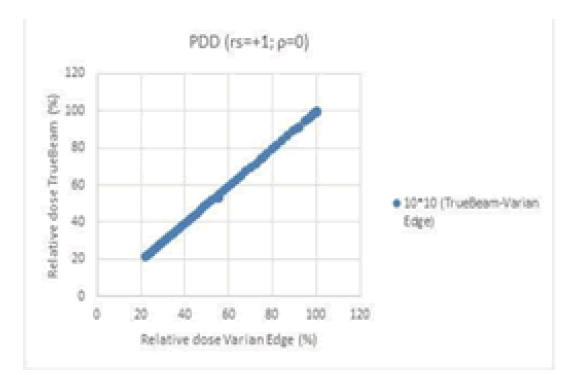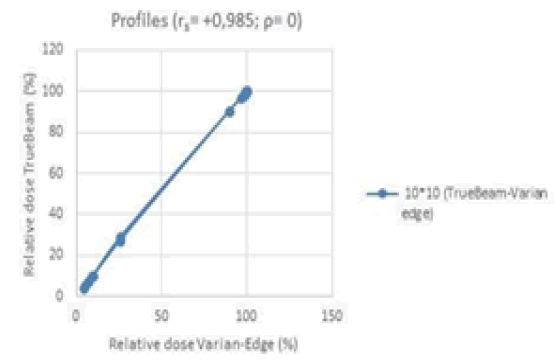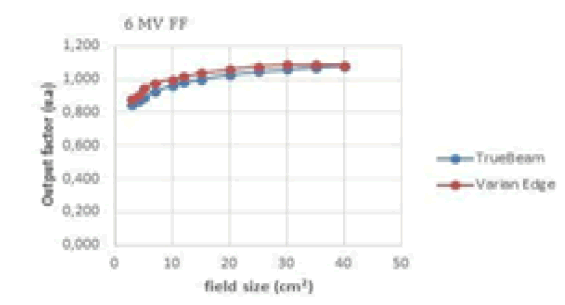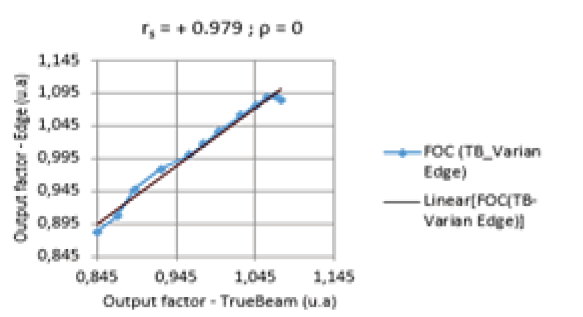Research Article - Onkologia i Radioterapia ( 2023) Volume 17, Issue 6
SPSS-based correlation analysis for flattened photon beams with energy of 6 MV between TrueBeam and Edge
Sara Archir1*, Mohammed El Adnani Krabch2, Bachouchi Mounir2 and Mourad Trihi12Oncology Clinic, Department of Medical Physics, Rabat, Morocco
Sara Archir, Department of Physics, FSAC, Hassan II University Casablanca, Morocco, Email: achir.sara1@gmail.com
Received: 27-Mar-2023, Manuscript No. OAR-23-93008; Accepted: 30-May-2023, Pre QC No. OAR-23-93008 (PQ); Editor assigned: 01-Apr-2023, Pre QC No. OAR-23-93008 (PQ); Reviewed: 28-Apr-2023, QC No. OAR-23-93008 (Q); Revised: 19-May-2023, Manuscript No. OAR-23-93008 (R); Published: 02-Jun-2023
Abstract
Transferring a patient from one linac to another for radiotherapy treatment necessitates the use of dosimetrically correlative linacs. By modeling the beam data into one dataset per linac treatment plan, the transfer reduces workflow and systemic dose delivery errors. In this study, the correlation between the dosimetric properties of the Varian Edge and TrueBeam 6 MV FF photon beams from IBM SPSS Statistics Version 22.0 was measured. The results from the comparison of percentage depth dose (rs = 0.999; ρ = 0), beam profile (rs = 0.989 ~ 0.994 ~ 0.987~ 0.981 ~ 0.930; ρ = 0) and output factor (rs= 0.979; ρ = 0) showed a perfect and strong correlation between the two accelerators.Furthermore, the Dmax was very similar and the quality index TPR(20/10), flatness, symmetry, and mean penumbra of TrueBeam (SD-120 MLC) were less than 1% and 1 cm smaller than Varian Edge. In comparison, the Varian Edge (HD -120 MLC) MLC transmission factor and dosimetric leaf gap values were two times higher and often two times lower than TrueBeam (SD-120 MLC), respectively. However, the results show that the MLC parameters varied greatly, resulting in uncorrelated linacs in the beam. This difference is due to the smaller leaf projection at the Varian Edge's isocenter. In stereotactic radiosurgery, the (HD-120 MLC) had the potential to improve dose conformity to the target volume and reduce dose to critical structures. Furthermore, the dosimetric leaf gap influences MLC treatment planning systems and is considered as a critical parameter in the equivalence between linear accelerators.
In the event of a malfunction or maintenance work, the patient cannot switch from one linac to another without having the treatment plan recalculated.
Keywords
spearman’s coefficient, beam correlated, ((HD-120 MLC)), dosimetric verification.
Introduction
Varian Medical Systems has delivered two accelerators to Morocco one specialized in stereotactic radiotherapy "Varian TrueBeam-LINAC" installed at the Achifaa Speciality Clinic in Casablanca and one designed for radiosurgery "Varian Edge" installed at the Oncology Clinic 16 November in Rabat. Standard flattening filter (FF) and flattening filter free (FFF) are used as types of photon beams in both versions of linear accelerator [1].
Varian's TrueBeam and Edge are equipped with a "multi- leaf collimator" that is attached to the accelerator head. The system consists of 120 “leaves”, arranged in two parallel rows (60 per bank) that revolve around the patient at different angles, allowing radiation to destroy tumors located in the body, brain and central nervous system. These tumors shrink, and blood vessels in the targeted area gradually close, cutting off the tumor's blood supply [2-5].
In addition to the advantages of "120 HD-MLC" already mentioned, the device has facilitated various delivery techniques for complex treatment volumes in terms of parameters such as (target coverage, dose to critical structures, monitor units per plan and treatment time) [6].
According to the accelerator manufacturer, the vast majority of new linac installed is energy correlated upon delivery. In this case, the treatment plan modelled the beam with one beam dataset, which saved time and effort for QA and commissioning while reducing systematic dose delivery errors.
In practice, this strategy has led many clinics to treat patients with a different linear accelerator than the one they were originally programmed to use [7-9].
Our goal in examining the energy beam correlation at 6 MV FF was to investigate the possibility of switching a patient from a Truebeam-LINAC (SD-120 MLC) to a Varian Edge radiosurgery system (HD- 120 MLC).
Material and Methods
The Kruskal-Wallis test was used in a previous search for 6 MV photon beams from the true beam accelerator to determine the homogeneity of dosimetric parameters between flattened (FF) and unflattened beams (FFF) [10].
In this search, the correlation coefficient, a statistical test typically used in medical research, was performed to analyze the correlation between two data sets of 6 MV FF photon beams from TrueBeam (SD-120 MLC) at Achifaa Specialist Center in Casablanca and Varian Edge (HD-120 MLC) at Oncology Clinic 16 November in Rabat (Morocco).
Correlation coefficient
All data analyses were performed with IBM SPSS Statistics version 22.0 for Windows; a Spearman's coefficient with a twosided "p" value of 0.05 or less indicates that the correlation is statistically significant. A c orrelation c oefficient ana lysis was determined to assess the strength of the correlation between the measured data from TrueBeam and Edge-Varian [11, 12].
Coefficients are expressed quantitatively and denoted by the letter It is interpreted as varying from no correlation (r=0) to negative or positive correlation (r=- 1, r=+1), indicating a very strong and complete correlation. A straight line from the origin to the higher x and y values traced this interval [13, 14].
Two Versions of Truebeam Data Comparison
In this work, the linacs commissioning beam data acquired for the photon mode consists of percentage depth dose (PDD), cross-plane profiles, multileaf collimator (MLC) transmission factor and a dosimetric leaf gap (DLG) measured with a cylindrical chamber; an output factor is measured using a PTW PinPoint chamber. The following setup conditions of the PDD were measured from 300 cm to 0 cm and profiles were taken at a depth of 10 cm (100 cm SSD) in a water phantom; the output factor, transmission factor and dosimetric leaf gap were measured at 5 cm depth (95 cm SSD) [15].
Percentage depth dose and beam pro ile:
PDD was defined as the dose at a given point Dx on the central axis that exceeds the maximum dose Dzmax on the central axis multiplied by 100 [15]. The dose profile co rresponds to th e variation of the dose in water, along with an axis perpendicular to the beam axis, at a different depth and for a different field size. Dose values were measured with the specified field size at depth (10 cm)
Beam analysis:
The beam quality specifications of the photon associated with 6 MV FF for a reference field size of 10 * 10 cm2 were examined and compared between two versions of True Beam:
• Dose ratio at 20 cm and 10 cm depth : TPR(20/10)= 1.2661 * D(20/10) - 0.0595 ;
• Dmax: depth of maximum dose;
• flatness calculated as maximum ratio between two points: F= (100×D max/Dmin);
• Symmetry was the maximum ratio between any two symmetrical data points: S= [100×D(x)/D(-x)]max;
• Mean penumbra (20%-80%): a spatial distance between 80% and 20% [10, 16-18].
Output factor showed as the ratio of the measured dose at the depth of each measured field size to the dose at the reference field size of 10*10 cm2 at the same depth [10].
Transmission factor was determined using film measurements,modeling the leakage dose through MLC leaves, calculated by taking the ratio of closed leaf doses (one leaf bank completely blocking the field) to open field doses across several leaves [18].
Dosimetric Leaf Gap (DLG): Also known as, the gap between the light and radiation fields, DLG was measured by extrapolating the size of the static or dynamic field formed by the MLC leaves to a size where the measured dose equals to the MLC leakage [19].
Results
Percentage Depth Dose and Pro iles
The respective profile curves of the two un its and the percentage depth dose are shown in (Figures 1 and 2). The measurement of the PDD curve was started at 300 mm from the chamber depth to the water surface. Beam profiles were measured for field sizes from 3*3 cm2 to 20*20 cm2 for 6 MV FF, respectively. The curves in both figures initially appeared to be similar. A diagram of the Spearman rank correlation of the beam properties for the reference field size (10 * 10 cm2 ) is shown in (Figures 3 and Figure 4).
Figure 1: Comparison of percentage depth dose curves for 6 MV FF Truebeam and Varian edge photon beams (3*3 to 20*20 cm2 )
Figure 2: Comparison of profile dose diagram for 6 MV FF-TrueBeam and Varian Edge photon beams (3*3 to 20*20 cm2 )
Figure 3: The Spearman’s rho correlation coefficient (r) is +1 for the PDD curve of 6 M FF TrueBeam vs Varian Edge photon beam with reference field size (10*10 cm2 ).
Figure 4: The Spearman’s rho correlation coefficient (r) is +0.985 for the dose profile of 6 MV FF TrueBeam vs Varian Edge photon beam with reference field size (10*10 cm2 )
According to this data, the following PDD and beam profile points were on the same line and had a similar increasing trend (r = +1 & + 0.985; ρ = 0). Using the curve data, the analytical Spearman's coefficient was approximately (rs = 0.999; ρ = 0) in terms of percent depth dose and beam profile as in in approximately (rs = 0.989 ~ 0.994 ~ 0.987~ 0.981 ~ 0.930; ρ = 0) for the respective field sizes. The results showed a near perfect and very strong positive correlation between the two TrueBeam versions (Table 1 and Table 2).
Tab.1: Average energy of PDD for 6 MV FF TrueBeam vs. Varian Edge photon beam at SSD = 100 cm
|
Unit (%) |
F.S ( cm2) | TrueBeam (SD-120 MLC) | Varian Edge (HD-120 MLC) | Spearman-rho coefficient rs | p-value | ||
|---|---|---|---|---|---|---|---|
| 6 MV FF | PDD | Mean | 3*3 | 53.166 | 53.223 | 0.9998 | 0 |
| 6*6 | 55.473 | 55.45 | 0.9999 | ||||
| 10*10 | 57.711 | 57.623 | |||||
| 15*15 | 59.452 | 59.405 | |||||
| 20*20 | 60.686 | 60.563 |
Tab.2: Average energy of beam profile for 6 MV FF TrueBeam vs. Varian Edge photon beams at SSD = 100 cm
| Unit % | FS (cm2) | TrueBeam (SD-120 MLC) | Varian Edge (HD-120 MLC) | Spearman-rho coefficient rs | p-value | ||
|---|---|---|---|---|---|---|---|
| 6 MV FF | Profiles | Mean | 3*3 | 18.61 | 29.824 | 0.989 | 0 |
| 6*6 | 30.248 | 46.855 | 0.994 | ||||
| 10*10 | 40.301 | 59.581 | 0.987 | ||||
| 15*15 | 42.235 | 69.263 | 0.981 | ||||
| 20*20 | 53.029 | 75.208 | 0.93 | ||||
In addition, the depth for the maximum dose Dmax, the quality index TPR(20/10) and the crossplane profile characteristics (flatness, symmetry, average penumbra) of two units for a reference field size of 10*10 cm2 are in (Tables 3 and 4) indicated. The TPR(20/10) difference for the calibration geometry approximates the Dmax values for the linac output calibration. At all off-axis distances, beam flatness and symmetry differences were less than (1 %) and the average penumbra was less than (1 cm) at the evaluated energy.
Tab.3 .Pdd Parameters For 6 Mv Ff Truebeam Vs Varian Edge Photon Beams At SSD = 100 Cm.
| TrueBeam (SD- | Varian Edge (HD-120 | ||||
|---|---|---|---|---|---|
| Energy | F.S ( cm2) | Unit | 120MLC) | MLC) | Diff (%) |
| 6 MV FF | 10*10 | Dmax (mm) | 15 | 15 | 0 |
| TPR{20/10} | 0.658 | 0.657 | -0.001 |
Tab.4: Flatness (%), symmetry (%) and average penumbra (cm) obtained from measurements of cross-plane profiles for 10 × 10 cm2 field at 10 cm depth of 6 MV FF truebeam vs. Varian edge photon beams.
| Unit (%) | F.S ( cm2) | TrueBeam | Varian Edge | Diff (%) | |
|---|---|---|---|---|---|
| (SD-120MLC) | (HD-120 MLC) | ||||
| 6 MV FF | Flatness (%) | 10*10 | 0,80 | 0,85 | -0,05 |
| Symmetry (%) | 0,60 | 0,65 | -0,05 | ||
| mean penumbrae (cm) | 5,79 | 5,80 | -0,01 | ||
Relative photon output factor
The photon output factors (Scp) for square field sizes ranging from 3x3 cm2 to 40x40 cm2 are shown in (Figure 5) and range from 0.845 to 1.078 for 6 MV FF TrueBeam (SD-120 MLC) and 0.882 to 1.084 for 6 MV FF Varian Edge (HD-120 MLC) (Table 5).
Figure 5: Output Factor for Energy 6 Mv FF Truebeam Vs Varian Edge.
Tab. 5. Output factor at source-to-surface distance (SSD) 95 cm of 6 MV FF photon beams from TrueBeam vs Varian Edge
| Unit (%) | F.S ( cm2) | TrueBeam (SD-120 MLC) | Varian Edge (HD-120 MLC) | Spearman-rho Coefficient rs | P-value | |
|---|---|---|---|---|---|---|
| 6 MV FF | Output Factor | 3*3 | 0.845 | 0.882 | 0.979** | 0 |
| 4*4 | 0.87 | 0.906 | ||||
| 5*5 | 0.892 | 0.947 | ||||
| 7*7 | 0.926 | 0.978 | ||||
| 10*10 | 0.962 | 1 | ||||
| 12*12 | 0.98 | 1.017 | ||||
| 15*15 | 1 | 1.037 | ||||
| 20*20 | 1.027 | 1.061 | ||||
| 25*25 | 1.046 | 1.077 | ||||
| 30*30 | 1.061 | 1.088 | ||||
| 35*35 | 1.071 | 1.09 | ||||
| 40*40 | 1.078 | 1.084 | ||||
| ** Correlation Was Assigned At Level 0.01 | ||||||
The points in the data set in (Figure 6) were aligned on a straight line for small fields (3*3 cm2 ) to 7*7cm2 , medium fields (10*10 cm2 ) to 12*12cm2 and large fields (30*30 cm2 ) to 40*40 cm2 . Although the points for 15 * 15 cm2 , 20 * 20 cm2 and 25 * 25 cm2 fields were practically above the line; the Spearman-rho correlation test for the output factor generally gives a slope (rs = 0.979) with a pa value < 0.01 indicates a very strong association between two ranges.
Figure 6:Spearman's rho correlation coefficient (r) is +0.979 of the output factor, from 6*6 to 40*40 cm2 of 6 MV FF photon beams TrueBeam vs Varian Edge.
Transmission factor /dosimetric leaf gap
The MLC parameters for energy 6 MV FF for two medical linear accelerators are shown in (Table 6) Varian Edge (HD-120 MLC) (0.415 mm) DLG values were typically two times lowers than TrueBeam (SD-120 MLC) (0.848 mm). As expected, the reported transmission factor values for Varian Edge (HD-120 MLC) were twice as high compared to TrueBeam (SD-120 MLC). Only the transmission factor and the dosimetric leaf gap differ between the two TrueBeam versions, which are due to the smaller leaf projection at the isocenter of Varian Edge
Tab. 6: MLC transmission factor and dosimetric leaf gap
| 6 MV FF | ||
|---|---|---|
| Depth 100 mm | TrueBeam (SD-120 MLC) | Varian Edge (HD-120 MLC) |
| MLC-TF (%) | 1.441 | 2.13 |
| DLG (mm) | 0.848 | 0.415 |
The MLC Transmission Factor (TF) and Dosimetric Leaf Gap (DLG) used to model the effect of rounded MLC leaf ends in Treatment Planning Systems (TPS), have been of great importance for accurate dose calculations, particularly in treatment with intensitymodulated radiation therapy (IMRT) or VMAT [10,20].
Discussion
Using a rank correlation coefficient from Spearman, this paper attempted to assess the similarity of data collected from a 6 MV FF photon beam between TrueBeam (SD- 120 MLC) and Varian Edge (HD- 120 MLC) in terms of percent depth dose, beam profile, MLC transmission factor, dosimetric leaf gap and output factor measurements [18-21].
Conclusion
PDDs, beam profile characteristics and output factor showed a strong linear correlation between two versions of Varian, although transmission factor (TF) and dosimetric leaf gap (DLG) values vary significantly more due to differences in the multileaf collimator (MLC) calibration procedure
In fact, TrueBeam-LINAC projects 5 mm wide MLC leaves on isocenter, while Varian Edge projects 2.5 mm wide leaves on isocenter projected Apart from differences in leaf width, MLCs differ in material composition and geometric properties (leaf thickness, tongue-and-groove design, and leaf-end curvature)
After years of use of HD-120 MLC, it proved to be more effective against cancer than MLCs standard. The high-resolution multileaf collimator used in stereotactic radiosurgery had the potential to improve dose conformity with target volume and reduce the dose of critical structures. The new system allows the fields to be freely shaped to adapt to the shape of the tumor.
In terms of linac equivalence, the results were consistent with the literature; the patient could be transferred from one linac to another in case of malfunction or maintenance work if the treatment plan was recalculated.
Acknowledgment
The author wishes to express gratitude to the thesis supervisor, Pr. Trihi Mourad from the Faculty of Sciences Ain Chock Casablanca, University Hassan II of Casablanca for his helpful advice on topic and features of article.
The author also likes to thank Dr. Bachouchi Mounir, general manager and Dr.Mohammed El Adnani Krabch, medical physicist, at the Oncology Clinic 16 November in Rabat, for their comments and suggestions in this work.
References
- Saidi K, El Baydaoui R, El Gouach H, Mesradi MR. Commissioning measurements of flattening filter and flattening filter free photon beams using a TrueBeam Stx® linear accelerator. Iran J Med Phys. 2021 ;18:49-62.
- Commissioning measurements of flattening filter and flattening filter free photon beams using a TrueBeam Stx® linear accelerator
- Stereotactic radiosurgery -Mayo Clinic. org (2019, 27 april) Cyberknife vs.truebeam (jul 21,2016) alaska cyberknife center Hanser Verlag, H.(2012). Intensity-Modulated Radiosurgery System.
- Kantz S, Söhn M, Troeller A, Reiner M, Weingandt H,et al. Impact of MLC properties and IMRT technique in meningioma and head-and-neck treatments. Radiation Oncology. 2015;10:1-5.
- Lin T, Hossain M, Fan J, Ma CM. When and how to treat an IMRT patient on a second accelerator without replanning?. Medical Dosimetry. 2018;43:334-43.
- Xu Z, Warrell G, Lee S, Colussi V, Zheng Y,et al. Assessment of beamâ?matched linacs quality/accuracy for interchanging SBRT or SRT patient using VMAT without replanning. J appl clin med phys. 2019 ;20:68-75.
- Treutwein M, Härtl PM, Groger C, Katsilieri Z, Dobler B. Linac twins in radiotherapy. Evolution of Ionizing Radiation Research. Rijeka: InTech. 2015:171-86.
[Google Scholar][Cross ref]
- Achir Sara, Mohammed El Adnani Krabch and Mourad Trihit . Analysis of dosimetric characteristics of energy 6 MV with and without flattening filter photon beam generated by the Varian TrueBeam linac using Kruskal Wallis H test. Onkol. Radioter.2022; 16:22- 29.
- Rojas-Lopez JA, Venencia D. Importance of Beam-Matching between TrueBeam STx and Novalis Tx in Pre-treatment quality assurance using portal dosimetry. J Med Phys. 2021;46:211.
- Chen PY, Popovich PM. Correlation: Parametric and nonparametric measures. Sage; 2002 .
- Rao CS, Raju SV. Similarity analysis between chromosomes of Homo sapiens and monkeys with correlation coefficient, rank correlation coefficient and cosine similarity measures. Genom data. 2016;7:202-209
- Schober P, Boer C, Schwarte LA. Correlation coefficients: appropriate use and interpretation. Anesthesia & analgesia. 2018; 126:1763-1768.
- Krabch ME, Chetaine A, Saidi K, Erradi FZ, Nourreddine A,et al. Measurements of photon beam flattening filter using an anisotropic analytical algorithm and electron beam employing electron monte carlo. Iran J Med Physics. 2019;16:200-9. .
- Al Mashud MA, Tariquzzaman M, Alam MJ, Zakaria GA. Photon beam commissioning of an Elekta Synergy linear accelerator. Pol. J. Med. Phys. Eng. 2017;23:115-9.
- Chang KH, Ji Y, Kwak J, Kim SW, Jeong C, et al. Clinical implications of high definition multileaf collimator (HDMLC) dosimetric leaf gap (DLG) variations. Prog. Med. Phys. 2016;27:111-6.
- Bergman AM, Gete E, Duzenli C, Teke T. Monte Carlo modeling of HD120 multileaf collimator on Varian TrueBeam linear accelerator for verification of 6X and 6X FFF VMAT SABR treatment plans. J. appl. clin. med. phys. 2014;15:148-63.
- Yao W, Farr JB. Determining the optimal dosimetric leaf gap setting for rounded leafâ?end multileaf collimator systems by simple test fields. J. Appl. Clin. Med. Phys. 2015 ;16:65-77.
- Ghazal M, Södergren L, Westermark M, Söderström J, Pommer T. Dosimetric and mechanical equivalency of Varian TrueBeam linear accelerators. J. Appl. Clin. Med. Phys. 2020;21:43-53.
- Fix MK, Volken W, Frei D, Frauchiger D, Born EJ, et al. Monte Carlo implementation, validation, and characterization of a 120 leaf MLC. Med. phys. 2011;38:5311-20.
- Robinson M, Tunstall C, Van den Heuvel F, Hobbs C, Padmanaban S. High quality clinical stereotactic radiosurgery planning and delivery with standard resolution (5 mm) multileaf collimation and multiple isocenters. Pract. Radiat. Oncol. 2020;10:293-300.
- Murai T, Hattori Y, Sugie C, Iwata H, Iwabuchi M, et al. Comparison of multileaf collimator and conventional circular collimator systems in Cyberknife stereotactic radiotherapy. J. radiat. res. 2017;58:693-700.
